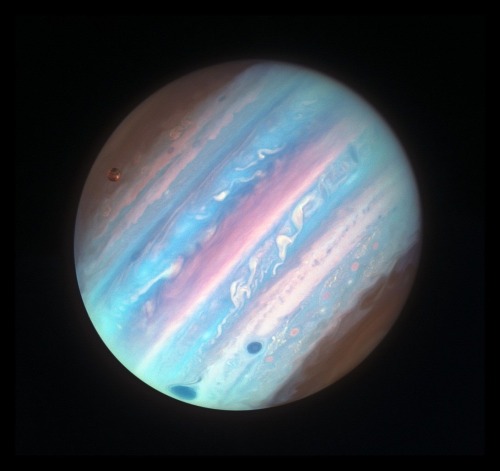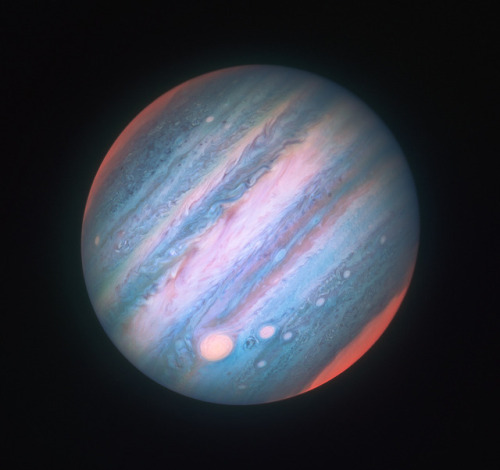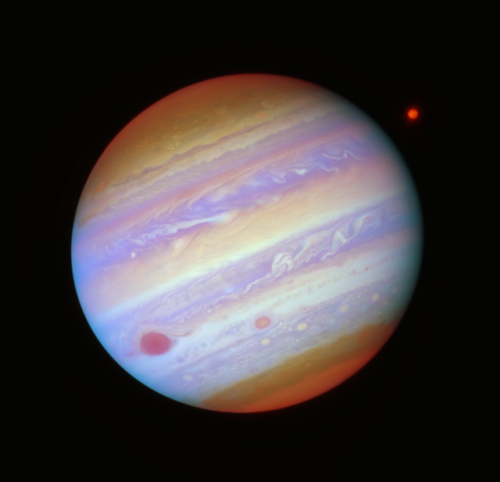Paul McCoubrie - Taken Just After The Sun Had Set Over The Alpine Mountains, This Optical Phenomenon

Paul McCoubrie - Taken just after the sun had set over the Alpine mountains, this optical phenomenon was a fleeting lovely vision that lasted for a few minutes only. It is caused by the sun below the horizon casting a shadow onto the clouds.
More Posts from Night-hides-the-world and Others

Southern Tadpole © Logan Carpenter

How far back in time the new James Webb Telescope can see vs. the Hubble
Gobble Up These Black (Hole) Friday Deals!
Welcome to our 6th annual annual Black Hole Friday! Check out these black hole deals from the past year as you prepare to head out for a shopping spree or hunker down at home to avoid the crowds.
First things first, black holes have one basic rule: They are so incredibly dense that to escape their surface you’d have to travel faster than light. But light speed is the cosmic speed limit … so nothing can escape a black hole’s surface!
Black hole birth announcements
Some black holes form when a very large star dies in a supernova explosion and collapses into a superdense object. This is even more jam-packed than the crowds at your local mall — imagine an object 10 times more massive than the Sun squeezed into a sphere with the diameter of New York City!

Some of these collapsing stars also signal their destruction with a huge burst of gamma rays. Our Fermi Gamma-ray Space Telescope and Neil Gehrels Swift Observatory continuously seek out the signals of these gamma ray bursts — black hole birth announcements that come to us from across the universe.
NICER black holes
There are loads of stellar mass black holes, which are just a few 10s of times the Sun’s mass, in our home galaxy alone — maybe even hundreds of millions of them! Our Neutron Star Interior Composition Explorer, or NICER for short, experiment on the International Space Station has been studying some of those relatively nearby black holes.

Near one black hole called GRS 1915+105, NICER found disk winds — fast streams of gas created by heat or pressure. Scientists are still figuring out some puzzles about these types of wind. Where do they come from, for example? And do they change the way material falls into the black hole? Every new example of these disk winds helps astronomers get closer to answering those questions.
Merging monster black holes
But stellar mass black holes aren’t the only ones out there. At the center of nearly every large galaxy lies a supermassive black hole — one with the mass of millions or billions of Suns smooshed into a region no bigger than our solar system.

There’s still some debate about how these monsters form, but astronomers agree that they certainly can collide and combine when their host galaxies collide and combine. Those black holes will have a lot of gas and dust around them. As that material is pulled into the black hole it will heat up due to friction and other forces, causing it to emit light. A group of scientists wondered what light it would produce and created this mesmerizing visualization showing that most of the light produced around these two black holes is UV or X-ray light. We can’t see those wavelengths with our own eyes, but many telescopes can. Models like this could help scientists know what to look for to spot a merger.
Black holes power bright gamma ray lights
It also turns out that these supermassive black holes are the source of some of the brightest objects in the gamma ray sky! In a type of galaxy called active galactic nuclei (also called “AGN” for short) the central black hole is surrounded by a disk of gas and dust that’s constantly falling into the black hole.

But not only that, some of those AGN have jets of energetic particles that are shooting out from near the black hole at nearly the speed of light! Scientists are studying these jets to try to understand how black holes — which pull everything in with their huge amounts of gravity — provide the energy needed to propel the particles in these jets. If that jet is pointed directly at us, it can appear super-bright in gamma rays and we call it a blazar. These blazars make up more than half of the sources our Fermi space telescope sees.
Catching particles from near a black hole
Sometimes scientists get a two-for-one kind of deal when they’re looking for black holes. Our colleagues at the IceCube Neutrino Observatory actually caught a particle from a blazar 4 billion light-years away. IceCube lies a mile under the ice in Antarctica and uses the ice itself to detect neutrinos, tiny speedy particles that weigh almost nothing and rarely interact with anything. When IceCube caught a super-high-energy neutrino and traced its origin to a specific area of the sky, they turned to the astronomical community to pinpoint the source.

Our Fermi spacecraft scans the entire sky about every three hours and for months it had observed a blazar producing more gamma rays than usual. Flaring is a common characteristic in blazars, so this didn’t attract special attention. But when the alert from IceCube came through, scientists realized the neutrino and the gamma rays came from the same patch of sky! This method of using two or more kinds of signals to learn about one event or object is called multimessenger astronomy, and it’s helping us learn a lot about the universe.

Get more fun facts and information about black holes HERE and follow us on social media today for other cool facts and findings about black holes!
Make sure to follow us on Tumblr for your regular dose of space: http://nasa.tumblr.com.

“The shockwave from a 20,000 year-old supernova explosion in the constellation of Cygnus is still expanding into interstellar space. The collision of this fast moving wall of gas with a stationary cloud has heated it causing it to glow in visible as well as high energy radiation, producing the nebula known as the Cygnus Loop (NGC 6960/95). The nebula is located a mere 1,400 light-years away. The colors used here indicate emission from different kinds of atoms excited by the shock: oxygen-blue, sulfur-red, and hydrogen-green. This picture was taken with the Wide Field and Planetary Camera 2 on board the Hubble Space Telescope.”
Photo by J Hester of ASU, description via NASA.



Jupiter (filtered) by Judith Schmidt.

What do you get when you combine a doctor, engineer & astronaut? Mae Carol Jemison! Dr. Jemison flew on Space Shuttle Endeavour in Sept 1992 to become the 1st African-American woman in space. The 7-day, 22-hour flight was the 50th Shuttle mission & had a focus on conducting microgravity investigations in materials & life sciences. Dr. Jemison also holds an amazing 9 doctorates; don’t know how that’s humanly possible; getting my BA was tough enough!

The phases of Venus as it orbits the Sun, illustrated by John Emslie in Astronomical Diagrams, 1851.
-
 possenrreisser liked this · 3 months ago
possenrreisser liked this · 3 months ago -
 fyodorokay liked this · 3 months ago
fyodorokay liked this · 3 months ago -
 wavywavy reblogged this · 3 months ago
wavywavy reblogged this · 3 months ago -
 spiritualitychakra reblogged this · 3 months ago
spiritualitychakra reblogged this · 3 months ago -
 realnerdyboy reblogged this · 3 months ago
realnerdyboy reblogged this · 3 months ago -
 crossedsardines liked this · 3 months ago
crossedsardines liked this · 3 months ago -
 babychurrro liked this · 3 months ago
babychurrro liked this · 3 months ago -
 leavinmethere liked this · 3 months ago
leavinmethere liked this · 3 months ago -
 myheartswildrumpus liked this · 3 months ago
myheartswildrumpus liked this · 3 months ago -
 journeying-man liked this · 3 months ago
journeying-man liked this · 3 months ago -
 north-star-dreamer-69 reblogged this · 3 months ago
north-star-dreamer-69 reblogged this · 3 months ago -
 north-star-dreamer-69 liked this · 3 months ago
north-star-dreamer-69 liked this · 3 months ago -
 dforce367 liked this · 3 months ago
dforce367 liked this · 3 months ago -
 macaronbee reblogged this · 3 months ago
macaronbee reblogged this · 3 months ago -
 cdnbadlands liked this · 3 months ago
cdnbadlands liked this · 3 months ago -
 realnerdyboy liked this · 3 months ago
realnerdyboy liked this · 3 months ago -
 merel69 liked this · 3 months ago
merel69 liked this · 3 months ago -
 theineffablewoman reblogged this · 3 months ago
theineffablewoman reblogged this · 3 months ago -
 theineffablewoman liked this · 3 months ago
theineffablewoman liked this · 3 months ago -
 bolboreteando reblogged this · 3 months ago
bolboreteando reblogged this · 3 months ago -
 thebearandthemoon reblogged this · 3 months ago
thebearandthemoon reblogged this · 3 months ago -
 ameliorar reblogged this · 3 months ago
ameliorar reblogged this · 3 months ago -
 prckovinky reblogged this · 3 months ago
prckovinky reblogged this · 3 months ago -
 gothiclines reblogged this · 3 months ago
gothiclines reblogged this · 3 months ago -
 letters-to-theo liked this · 4 months ago
letters-to-theo liked this · 4 months ago -
 rubensdaughter reblogged this · 4 months ago
rubensdaughter reblogged this · 4 months ago -
 exiledfromverona liked this · 5 months ago
exiledfromverona liked this · 5 months ago -
 sunsetmaiden reblogged this · 5 months ago
sunsetmaiden reblogged this · 5 months ago -
 annapt99w liked this · 6 months ago
annapt99w liked this · 6 months ago -
 22wave liked this · 8 months ago
22wave liked this · 8 months ago -
 tirodiritto reblogged this · 10 months ago
tirodiritto reblogged this · 10 months ago -
 stone-below-the-water reblogged this · 1 year ago
stone-below-the-water reblogged this · 1 year ago -
 stone-below-the-water liked this · 1 year ago
stone-below-the-water liked this · 1 year ago -
 tmbyykk liked this · 1 year ago
tmbyykk liked this · 1 year ago -
 wayti-blog liked this · 1 year ago
wayti-blog liked this · 1 year ago -
 hopeful-infj reblogged this · 1 year ago
hopeful-infj reblogged this · 1 year ago -
 fayzee liked this · 1 year ago
fayzee liked this · 1 year ago -
 memories-of-a-lost-soul reblogged this · 1 year ago
memories-of-a-lost-soul reblogged this · 1 year ago -
 bisexxualcowboy reblogged this · 1 year ago
bisexxualcowboy reblogged this · 1 year ago -
 ace-disaster-weeb liked this · 1 year ago
ace-disaster-weeb liked this · 1 year ago -
 bybobbysbeard liked this · 1 year ago
bybobbysbeard liked this · 1 year ago -
 shebelievedsoshedid reblogged this · 1 year ago
shebelievedsoshedid reblogged this · 1 year ago -
 phantasticx reblogged this · 1 year ago
phantasticx reblogged this · 1 year ago -
 idioticboyz reblogged this · 1 year ago
idioticboyz reblogged this · 1 year ago -
 dreamboy-wonder reblogged this · 1 year ago
dreamboy-wonder reblogged this · 1 year ago -
 idioticboyz liked this · 1 year ago
idioticboyz liked this · 1 year ago
Astronomy and the other wonders you witness when you look to the skies.
115 posts


